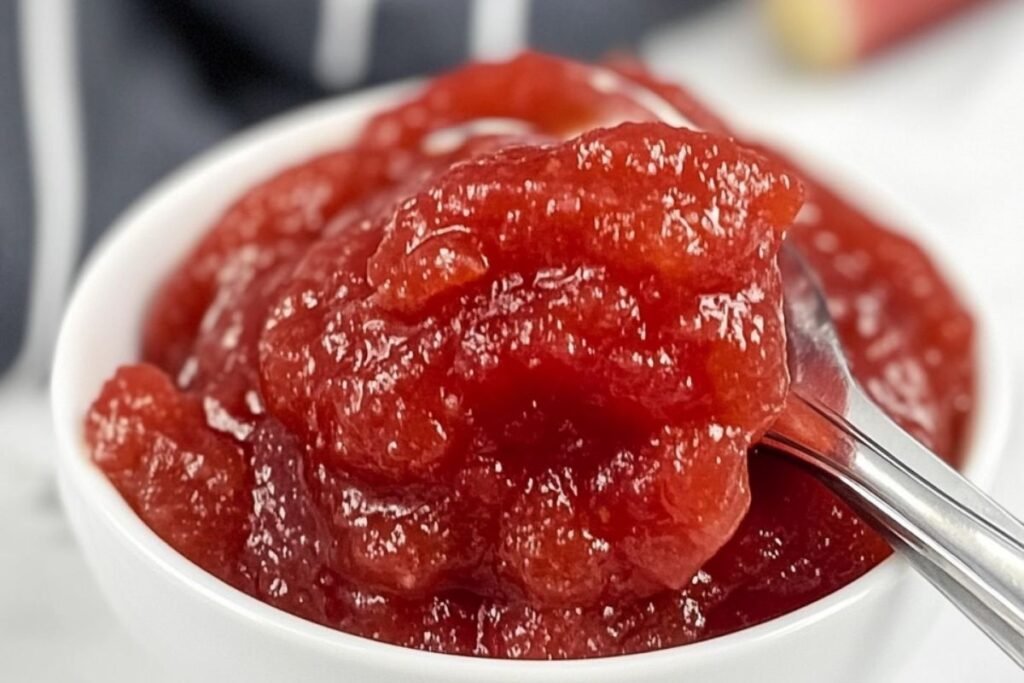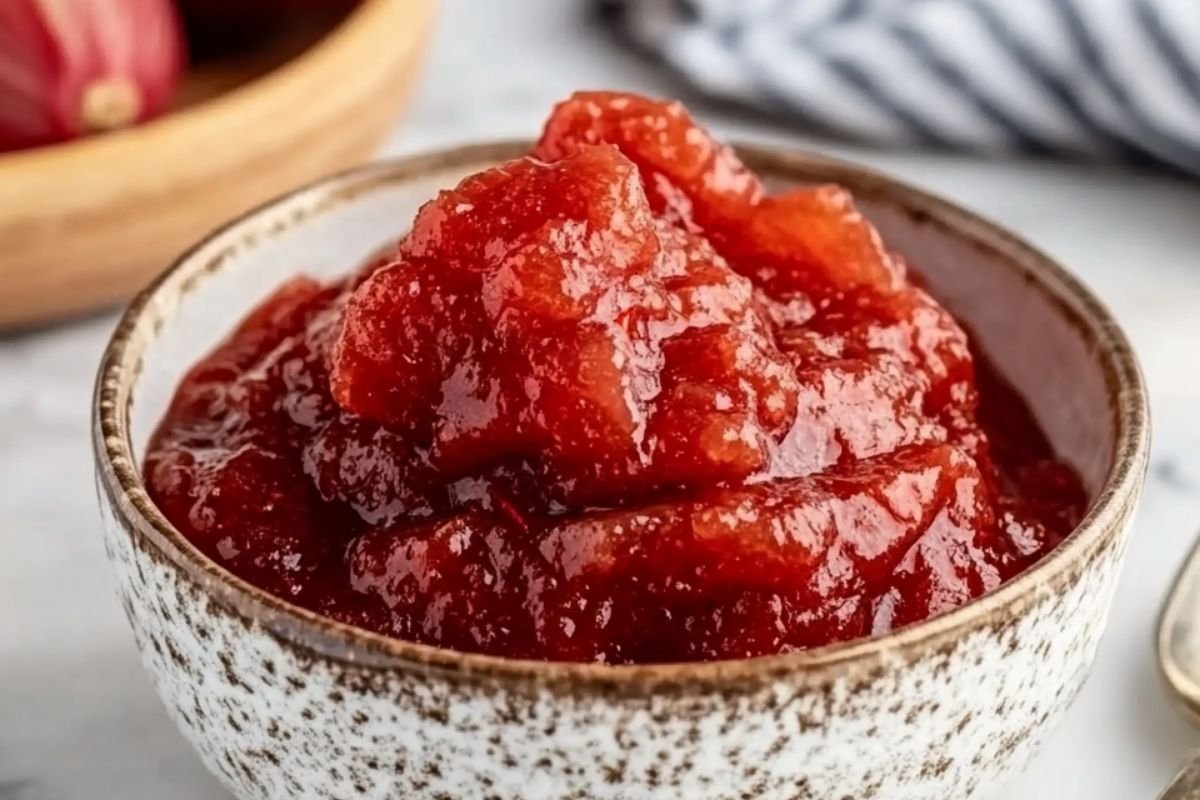Rhubarb is often typecast as just a pie ingredient, but it’s so much more than that. If you’re looking for the simplest way to enjoy this tart vegetable, look no further than rhubarb sauce. This versatile treat is equal parts tangy and sweet, incredibly easy to make, and perfect for everything from pancakes to pork chops.
In this complete guide, we’ll walk you through how to make rhubarb sauce from scratch, why it deserves a spot in your fridge year-round, and how to customize it to your taste. With over 5,000 words of expert insight, recipe guidance, variations, FAQs, and more—this is your ultimate resource for all things rhubarb sauce.
Table of Contents
- What Is Rhubarb Sauce?
- Why You Should Be Making It
- Health Benefits of Rhubarb
- Essential Ingredients
- Classic Rhubarb Sauce Recipe (Step-by-Step)
- How to Customize Rhubarb Sauce
- Flavor Add-Ins and Sweetener Options
- Serving Suggestions for Rhubarb Sauce
- Storage, Canning & Freezing Tips
- Rhubarb Sauce Variations (Spicy, Strawberry, Vanilla & More)
- Common Mistakes to Avoid
- Frequently Asked Questions (FAQs)
- Conclusion
1. What Is Rhubarb Sauce?
Rhubarb sauce is a smooth or chunky fruit-style condiment made by simmering rhubarb with sugar and water until it breaks down into a jammy, pourable mixture. Think applesauce—but tangier, more vibrant, and with a beautiful pink hue. It can be enjoyed warm or chilled, spooned over breakfast dishes or desserts, and even paired with savory items.
2. Why You Should Be Making It
- Incredibly Easy: Ready in 20 minutes, no fancy tools required.
- Endlessly Versatile: Great with pancakes, yogurt, meats, or ice cream.
- Budget-Friendly: Uses seasonal produce, minimal ingredients.
- Customizable: Sweeten it your way or infuse with spices or herbs.
- Freezer-Friendly: Make a big batch and store it for months.
Whether you’re a rhubarb newbie or an experienced cook, this sauce is one of the easiest and most satisfying ways to enjoy the vegetable.
3. Health Benefits of Rhubarb
Rhubarb isn’t just tasty—it’s nutrient-dense and offers health perks too.
Key Benefits:
- High in fiber: Supports digestion
- Rich in antioxidants: Protects cells from damage
- Low in calories: Only ~26 calories per cup
- Contains vitamin K: Crucial for bone health
- May help reduce cholesterol (per some early studies)
Pair it with a moderate amount of natural sweetener, and rhubarb sauce becomes both delicious and functional.
4. Essential Ingredients
You’ll only need a few ingredients to make a basic rhubarb sauce:

- Rhubarb: Fresh or frozen, chopped into ½-inch pieces.
- Water: Just enough to help the fruit break down.
- Sugar: Granulated is classic; others are optional (see below).
- Optional Add-ins: Vanilla, cinnamon, lemon zest, strawberries, etc.
You can scale this recipe easily based on how much rhubarb you have.
5. Classic Rhubarb Sauce Recipe (Step-by-Step)
Ingredients:
- 4 cups chopped rhubarb (fresh or frozen)
- ¾ cup granulated sugar (adjust to taste)
- ½ cup water
Instructions:
Step 1: Prepare Rhubarb
- Trim off leaves (toxic!) and slice stalks into ½-inch pieces.
Step 2: Combine Ingredients
- Add rhubarb, sugar, and water to a medium saucepan.
Step 3: Simmer
- Bring to a boil, then reduce heat to low.
- Simmer uncovered, stirring occasionally, for 15–20 minutes.
Step 4: Adjust Texture
- Use a spoon for a chunky sauce or an immersion blender for smooth.
Step 5: Taste and Cool
- Taste and adjust sweetness. Let cool before storing.
You’ve just made a batch of rhubarb sauce from scratch!
6. How to Customize Rhubarb Sauce
One of the best things about this sauce is how adaptable it is.
Texture Options:
- Chunky: Leave it as is, with visible fruit bits.
- Smooth: Blend with a stick blender or food processor.
Sweetness Levels:
- Adjust sugar up or down.
- Try honey, maple syrup, or stevia for a healthier twist.
7. Flavor Add-Ins and Sweetener Options
Rhubarb pairs beautifully with:
Fruits:
- Strawberries
- Apples
- Oranges
- Raspberries
Spices & Herbs:
- Cinnamon
- Nutmeg
- Cloves
- Fresh ginger
- Basil or mint (just a touch!)
Extracts:
- Vanilla extract
- Almond extract
- Orange zest
Sweeteners:
- Brown sugar
- Maple syrup
- Honey
- Agave nectar
Adjust based on dietary needs or flavor preference.
8. Serving Suggestions for Rhubarb Sauce
Don’t underestimate how many dishes this sauce can elevate. Try it:
At Breakfast:
- Over pancakes or waffles
- Swirled into oatmeal or porridge
- Layered with Greek yogurt and granola
- On top of toast or English muffins
For Dessert:
- As a topping for vanilla ice cream
- Over pound cake or cheesecake
- In tarts or fruit crisps
- Stirred into whipped cream or pudding
With Savory Dishes:
- Glazed over grilled chicken
- Paired with roasted turkey or beef
- Served alongside pork chops
9. Storage, Canning & Freezing Tips
Refrigerator:
- Store in an airtight jar.
- Lasts 1 to 2 weeks.
Freezing:
- Cool completely, then spoon into freezer-safe containers.
- Freeze for up to 6 months.
- Thaw in the fridge overnight.
Canning:
- For long-term shelf storage, follow proper water bath canning instructions.
- Use sterilized jars and process per USDA guidelines.
10. Rhubarb Sauce Variations (Spicy, Strawberry, Vanilla & More)
1. Strawberry-Rhubarb Sauce
- Use 2 cups rhubarb + 2 cups strawberries. Perfect for dessert toppings!
2. Rhubarb-Vanilla Sauce
- Add 1 tsp vanilla extract after cooking for a mellow, rich finish.
3. Spiced Rhubarb Sauce
- Simmer with 1 stick cinnamon, a pinch of nutmeg, and ¼ tsp ground ginger.
4. Rhubarb-Chili Sauce (Savory)
- Add minced red chili and reduce sugar for a spicy meat glaze.
5. Rhubarb-Apple Sauce
- Combine equal parts rhubarb and diced apples for a fall-friendly twist.
11. Common Mistakes to Avoid
- Skipping sugar entirely: Rhubarb is very tart; balance is key.
- Using rhubarb leaves: Always discard—leaves are toxic.
- Overcooking: Can make sauce too watery or break down flavor.
- Wrong pot size: Sauce can bubble up—use a medium saucepan.
- Not stirring enough: Sugar can stick or burn at the bottom.
12. Frequently Asked Questions (FAQs)
Q: Can I use frozen rhubarb?
Absolutely. No need to thaw—just toss in the pot and cook longer.
Q: Do I need to peel rhubarb?
Not at all. Just wash and slice.
Q: Is this sauce kid-friendly?
Yes—just sweeten slightly more for younger tastebuds.
Q: Can I can rhubarb sauce?
Yes, but follow safe canning guidelines and acidify if needed.
Q: How long does it last in the fridge?
Up to 1–2 weeks in an airtight container.
Q: Is this gluten-free?
Naturally gluten-free!
Q: Can I use artificial sweeteners?
Yes, though taste may vary slightly. Try erythritol, monk fruit, or stevia blends.
Q: What’s the best sugar alternative?
Maple syrup and honey add depth. Use ½ to ⅔ cup per 4 cups rhubarb.
Q: Can I blend it smooth?
Definitely—use an immersion blender or standard blender after cooking.
Q: Does rhubarb sauce go with savory foods?
Yes! It’s great on pork, turkey, and grilled meats.
13. Conclusion
Rhubarb sauce is one of the simplest, most rewarding ways to enjoy this seasonal ingredient. Whether you make it as a pancake topper, dessert drizzle, or freezer staple, it checks all the boxes: easy, affordable, customizable, and delicious.
Once you’ve made it once, you’ll find endless reasons to whip up another batch. From spring through fall, rhubarb sauce belongs in every kitchen. With just three ingredients and one pot, there’s no excuse not to try it today.
